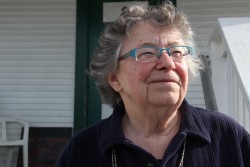
Nancy Yaw Davis and her husband Bill Davis survived the 1964 Great Alaska earthquake in Anchorage. (KCAW photo/Emily Forman)
March 27th marks the 50th anniversary of Alaska’s Good Friday Earthquake. Many Sitkans have stories from the epicenter. This is the third story in a four-part series.
Sitka residents Bill Davis and Nancy Yaw Davis lived in Anchorage in 1964. Bill was the chairman of the Alaska Mountain Rescue Group. He headed the civilian rescue effort at the center of the largest earthquake that North America has ever seen. But, he insists that Nancy’s story is more compelling. After the disaster, Nancy devoted many years to studying the aftermath – culminating in a doctoral dissertation. She remembers the survivors from the village of Kaguyak the most.
Nancy: Wanna start with Bill?
Bill: Oh OK, I’m Bill Davis. We’ve been living here in Sitka for five years and this is Nancy.
Nancy: Hello.
Nancy: The trauma of the earthquake was something we shared in 1964 at 5:36. Bill where were we?
Bill: Well we lived in east Anchorage at that time.
Nancy: What do you remember about those first five minutes?
Bill: Well, as the bookcase started to walk across the floor was when I decided it was time to get out.
Nancy: I don’t know who left first but I went outside and I kind of held on to the little VW bug.
Bill: But what I remember most was the alders and the cottonwoods across the street, wild swinging back and forth.
Nancy: There was no question it was an earthquake but the seriousness of the earthquake did not register until later in the evening when I was in the car seven months pregnant at the corner of 36th and Lake Otis while Bill was out with… Did you have flash lights or flares? He was direction traffic.
Bill: Yeah, the standard stuff you know. Set up a grid and section it off and send people to it. There was nothing unusual about that. You’re the one that had more fun though.
Nancy: Well, yes. It gave me an opportunity to gather an incredible amount of data with the villagers of Old Harbor and Kaguyak who were evacuated to Airport Heights school. I met them in Anchorage and actually that’s where I recorded their original stories. That’s where I lugged around this big reel to reel tape recorder. I interviewed 16 of the 19 surviving adults from Kaguyak between April 1st and April 10th of 1964. It was American Good Friday and they were just finishing this church that they had built with their own funds. About $1,600 of their own funds. They were able to establish right away who was lost and who was there.
Bill: Nancy was the only one who did any kind of systematic research with the small villages after the earthquake and particularly the follow-up stuff.
Nancy: Well the next year I went to Akhiok and I found the Kaguyak people were there. I think about five houses had been built by the BIA(Bureau of Indian Affairs). I think it was difficult politically for and for the lay leadership in the church. But those are things that would come whenever… and this is often the case as people just assume, you put villages together and it will merge without realizing the cultural richness of each separate village. I think they still mourn Kaguyak but it would’ve been harder to go back when the church was not there.
Nancy: When did I not think about disasters. There continue to be disasters one after another Haiti, Sumatra… Yes it’s embedded in my brain I guess whenever there’s a disaster I think well there’s going to be a convergence. The disaster syndrome will kick in again. There will be a convergence. Outside people trying to tell local people, local survivors, how they should do things. There will be levels of people and goods and money and chaos.






























